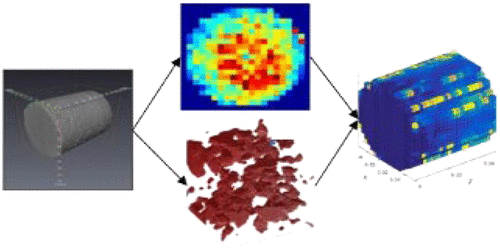当前位置:
X-MOL 学术
›
Energy Fuels
›
论文详情
Our official English website, www.x-mol.net, welcomes your
feedback! (Note: you will need to create a separate account there.)
Integrated Digital Rock Construction Workflow for Chemical Enhanced Oil Recovery Numerical Simulation
Energy & Fuels ( IF 5.2 ) Pub Date : 2021-09-01 , DOI: 10.1021/acs.energyfuels.1c02301 Yifu Han 1 , Kailei Liu 2
Energy & Fuels ( IF 5.2 ) Pub Date : 2021-09-01 , DOI: 10.1021/acs.energyfuels.1c02301 Yifu Han 1 , Kailei Liu 2
Affiliation

|
Core-scale laboratory experiments on rock samples are widely used to evaluate the efficiency of potential chemical enhanced oil recovery (EOR) agents for future field-scale production plans. However, in some cases the amount of core plugs obtained from interested formations is not sufficient for various evaluation experiments. In addition, a core plug cannot be easily restored to its initial state after several cycles of core-flooding and cleaning processes due to porosity and permeability reductions or wettability changes, so the evaluation of various EOR agents on the same core plug can be biased and has some uncertainties. To that end, a digital rock can be constructed and numerical simulations on it will help to mitigate those issues. Micro-CT scanning technology can be used to reveal and capture the internal structure of rock, which makes the constriction of a digital rock and multiphase fluid flow numerical simulations on it possible. In this study, we propose an integrated digital rock construction workflow which upscales pore-scale simulation results to core-scale rock physics models including porosity and directional permeability. The newly proposed workflow combines the Lattice Boltzmann method (LBM) and the Kriging method to accurately and effectively estimate a directional permeability model. We apply this workflow to construct a digital rock of one carbonate core plug and calculate the porosity and permeability of the constructed digital rock and compare them with laboratory measurements. The image-analyzed porosity is comparable with laboratory measurements with only 0.68% relative error. The simulated permeability with calibration is also in a good agreement with experimental results with 1.18% relative error. Finally, we simulate polymer-flooding on the constructed digital rock. The accurately constructed digital rock only has 10 143 grids including inactive grids, which greatly reduce the computational time of chemical EOR simulation without losing pore-space structure and rock heterogeneity information and makes the proposed method more practical in routine analysis and modeling.
中文翻译:

用于化学提高采油率数值模拟的集成数字岩石施工工作流程
岩石样品的岩心规模实验室实验被广泛用于评估潜在的化学提高石油采收率 (EOR) 药剂的效率,以用于未来的现场规模生产计划。然而,在某些情况下,从感兴趣的地层获得的岩心塞的数量不足以进行各种评估实验。此外,由于孔隙度和渗透率的降低或润湿性的变化,岩心塞在经过几次岩心驱替和清洗过程后不容易恢复到其初始状态,因此对同一岩心塞上的各种 EOR 剂的评价可能存在偏差和有一些不确定性。为此,可以构建数字岩石,对其进行数值模拟将有助于缓解这些问题。Micro-CT扫描技术可用于揭示和捕捉岩石的内部结构,这使得数字岩石的收缩和多相流体流动数值模拟成为可能。在这项研究中,我们提出了一个集成的数字岩石施工工作流程,将孔隙尺度模拟结果升级为包括孔隙度和定向渗透率在内的核心尺度岩石物理模型。新提出的工作流程结合了格子玻尔兹曼法 (LBM) 和克里金法,可以准确有效地估计定向渗透率模型。我们应用此工作流程来构建一个碳酸盐岩芯塞的数字岩石,并计算构建的数字岩石的孔隙度和渗透率,并将它们与实验室测量结果进行比较。图像分析的孔隙率与实验室测量值相当,相对误差仅为 0.68%。校准后的模拟渗透率也与实验结果吻合良好,相对误差为 1.18%。最后,我们在构建的数字岩石上模拟聚合物驱。精确构建的数字岩石只有10 143个网格,包括非活动网格,在不丢失孔隙空间结构和岩石非均质性信息的情况下,大大减少了化学EOR模拟的计算时间,使该方法在常规分析和建模中更具实用性。
更新日期:2021-09-16
中文翻译:

用于化学提高采油率数值模拟的集成数字岩石施工工作流程
岩石样品的岩心规模实验室实验被广泛用于评估潜在的化学提高石油采收率 (EOR) 药剂的效率,以用于未来的现场规模生产计划。然而,在某些情况下,从感兴趣的地层获得的岩心塞的数量不足以进行各种评估实验。此外,由于孔隙度和渗透率的降低或润湿性的变化,岩心塞在经过几次岩心驱替和清洗过程后不容易恢复到其初始状态,因此对同一岩心塞上的各种 EOR 剂的评价可能存在偏差和有一些不确定性。为此,可以构建数字岩石,对其进行数值模拟将有助于缓解这些问题。Micro-CT扫描技术可用于揭示和捕捉岩石的内部结构,这使得数字岩石的收缩和多相流体流动数值模拟成为可能。在这项研究中,我们提出了一个集成的数字岩石施工工作流程,将孔隙尺度模拟结果升级为包括孔隙度和定向渗透率在内的核心尺度岩石物理模型。新提出的工作流程结合了格子玻尔兹曼法 (LBM) 和克里金法,可以准确有效地估计定向渗透率模型。我们应用此工作流程来构建一个碳酸盐岩芯塞的数字岩石,并计算构建的数字岩石的孔隙度和渗透率,并将它们与实验室测量结果进行比较。图像分析的孔隙率与实验室测量值相当,相对误差仅为 0.68%。校准后的模拟渗透率也与实验结果吻合良好,相对误差为 1.18%。最后,我们在构建的数字岩石上模拟聚合物驱。精确构建的数字岩石只有10 143个网格,包括非活动网格,在不丢失孔隙空间结构和岩石非均质性信息的情况下,大大减少了化学EOR模拟的计算时间,使该方法在常规分析和建模中更具实用性。











































 京公网安备 11010802027423号
京公网安备 11010802027423号